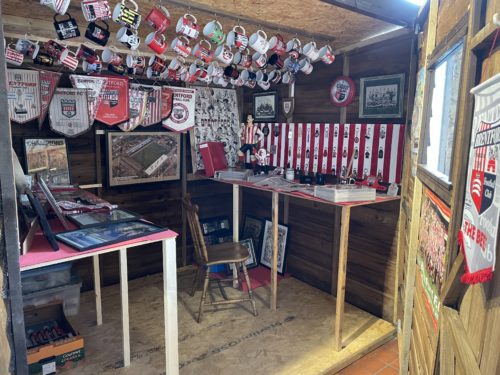Who can forget that glorious evening when after many months of planning the exhibition at the London Museum of Steam and Water finally opened? The collaboration with the club and Bees United proved to be a successful event. With over one hundred invited guests including the Pitt Family in attendance it was an emotional evening. Here’s the great video which Stuart Hughes made that night, its now on our BU YouTube channel
To top it all we went and beat Arsenal 2-0. The exhibition closed on 8th May and to round things of we went on to beat Southampton 3-0.
Given the constant change to the fixtures, thank you SKY, and our opponents’ escapades in Europe, I attended the museum on every occasion that the museum’s opening times coincided with a Brentford fixture. For at least two to three hours I met supporters and talked to them explaining the story behind some of the exhibits despite there being explanations to accompany the exhibits.
Supporters came in groups, with probably there being fifteen to thirty people in attendance during each time I was there.
Among the people visiting the exhibition was Andrew Dean, his father John was a friend of John Pitt whose memorabilia was one of the corner stones of the exhibition. John Dean was unable to travel up from Dorset to view the exhibition. However, Andrew explained that the two Johns would travel together the length and breadth of England watching Brentford. They probably saw them lose more games than we won. Sadly, John Dean, who was Brentford’s oldest ever matchday mascot died on the 3rd January. He supported Brentford for 90 years.
Supporters enjoyed reading about the journey from Griffin Park to Lionel Road, some too young to appreciate the hard work that went into the ABeeC campaign. The memorabilia of Arthur Charlton who played for Brentford in the 1890s. The money raising efforts to help raise funds for Bees United to keep the club alive.

The explanation behind the Pitt Collection. Although there was a written explanation supporters enjoyed hearing first-hand how we came by the memorabilia and the sympathetic way in which it was removed from John Pitt’s home. We also included the last few minutes of the play-off final commentary. Was it really a year ago?
Then there was the John Chandler programme exhibits and the explanation of how when serving on HMS Cairo in 1942 his ship was torpedoed. Unable to get back to his cabin to retrieve his fully autographed London War Cup Final programme it went down with the ship. John’s father sent him a replacement, which was on display. The single team sheets produced during and after the WW2. Due a paper shortage these were meant to be recycled; John kept all his. John supported Brentford from 1930s until the age of 93 he was no longer able to travel. His final game was the Johnstone Paint Trophy final against Carlisle.
The centre spot from Griffin Park encased in Perspex, that will now go on display at Lionel Road
We encouraged visitors to complete feedback forms to gauge their opinions on both the exhibits on display and if there were any interest in a further exhibition. Overall there is a wish to see further exhibitions, even something more permanent close to Lionel Road. Visitors wanted to see more about football shirts down the years, more about the failed attempt by QPR to put us out of business in 1967, and more trophies, photographs and something about the iconic Royal Oak Stand.
The feedback forms also showed that 100% of those attended the exhibition rated it, good (3%,), very good (32%), and excellent (65%).
The quality of items on display good (6%), very good ((39%), excellent (55%)
The explanations given to support the items on display, good (3%), very good (45%) and excellent (52%)
The club has a vast amount of memorabilia in store that most supporters would never have seen even when we were at Griffin Park. Items represent a social history of the club. The players used to receive match reporting instructions by telegram in the days before telephones. Social media wasn’t even on the horizon. Speaking to a young girl visitor, she didn’t know there was such a thing as a telegram.
There are players contracts for the 1930s. they were paid £5 a week another £1 if they won a game.
One further item in store is a small shield that smells of smoke. It was one of the few items recovered when the Braemar Road stand was destroyed by fire 37 years ago.
To not create something more permanent would be an opportunity missed. The chance to explain more about our 133 year history should not be allowed to just be stored away from future generations. It would also enhance the visitor experience and give supporters something else to do ahead of the match day experience.

